Antireflective Coatings Market Research, 2030
The global antireflective coatings market was valued at $4.3 billion in 2020, and is projected to reach $8.9 billion by 2030, growing at a CAGR of 7.6% from 2021 to 2030.
Report Key Highlighters:
-
The antireflective coatings market has been analyzed in value and volume. The value, and volume of the antireflective coatings market are analyzed in millions of USD and tons respectively.
-
This report also provides a detailed impact analysis related to various government policies towards the antireflective coatings market in the key regulation analysis chapter.
-
This report also provides a pricing analysis of the antireflective coatings by region in $/ton.
-
Global antireflective coatings market is fragmented in nature with many players such as Essilor International, Carl Zeiss AG, E. I. du Pont de Nemours Company, Koninklijke DSM N.V., Honeywell International, PPG Industries, Hoya Corporation, Viavi Solutions, Inc., Optical Coatings Japan, and Rodenstock GmbH. Also tracked key strategies such as product launches, acquisitions, mergers, expansion, etc. of various manufacturers of antireflective coatings.
-
Conducted primary interviews with raw material suppliers, wholesalers, suppliers, and manufacturers of the antireflective coatings market to understand the market trends, growth factors, pricing, and key players’ competitive strategies.
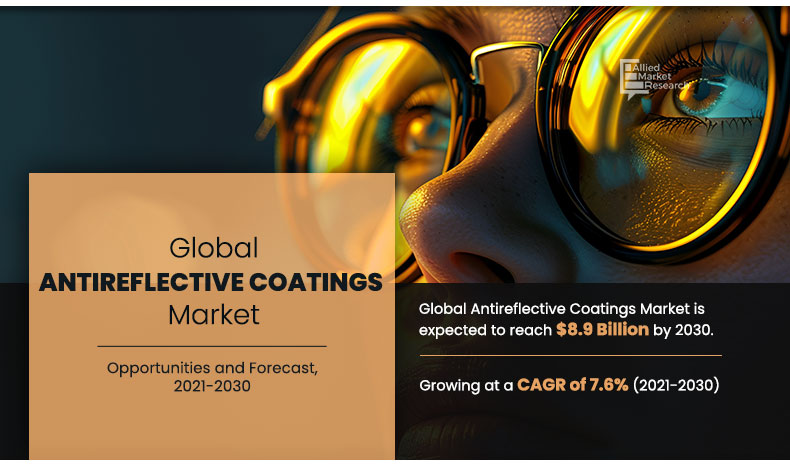
Anti-reflection coatings are optical coatings designed to reduce reflections from the optical surface. These coatings improve visibility & contrast when used in common imaging systems and complex systems such as telescopes &solar panels. In addition, it efficiently increases the transmittance of the lens surface. Anti-reflective coatings on eyewear provide a crisp view and are resistant to scratches, water, and dust. Anti-reflective glasses protect your eyes from glare when working on your computer for extended periods of time, preventing eye fatigue and eye strain.
The growth of the anti-reflective coating market is driven by increase in demand for anti-reflective coatings from the eyewear and photovoltaic industry and surge in acceptance of anti-reflective glasses in the construction industry. However, the high cost associated with the product and the lack of awareness among consumers and service providers curb the market growth. Continued progress in the anti-reflective coating market, such as the development of improved coatings, self-cleaning coatings, and coatings with improved durability that provide better power supply for solar panels, is favorable and expected to provide a lucrative opportunity for its market growth.
The global anti-reflective coating market is expected to grow significantly during the forecast period as anti-reflective coatings are increasingly used in the eyewear &photovoltaic industry and the importance of anti-reflective coatings in optical lenses is increasing. In addition, anti-reflective coatings are used to increase the energy efficiency of solar panels, complementing market growth. However, the high cost associated with the product is a major barrier to this market. Innovations in existing application technologies offer a great opportunity to expand the anti-reflective coating market.
The antireflective coatings market is segmented on the basis of technology, application, layer type and region.
On the basis of technology, the market is categorized into vacuum deposition, electronic beam evaporation, sputtering, and others (ion assisted deposition). Antireflective coatings market application covered in the study include eyewear, electronics, solar panels, automobile, and others (telecommunications, telescope, and binocular lenses). On the basis of layer type, the market is categorized into single layered and multi layered. The global antireflective coatings market is analyzed on the basis of four regions, which include North America, Europe, Asia-Pacific, and LAMEA. North America accounted for largest market share of the total revenue in 2020. The high adoption of Antireflective coatings products in the region is anticipated to continue to bolster the antireflective coatings market size, due to increase in the consumption of consumer goods in this region.
The key players operating in the global antireflective coatings market are Essilor International, Carl Zeiss AG, E. I. du Pont de Nemours and Company, Koninklijke DSM N.V., Honeywell International, PPG Industries, Hoya Corporation, Viavi Solutions, Inc., Optical Coatings Japan, and Rodenstock GmbH. Other players in the antireflective coatings industry value chain (not profiled in the report) include Eksma Optics, Evaporated Coatings, Inc., Torr Scientific Limited, Optics Balzers, Enki Technology, Zygo Corporation, Spectrum Direct Ltd., Quantum Coating, Lumentum Operations LLC, Majestic Optical Coatings, and Optimum RX Lens Specialists., etc. and are competing for the share of the market through product launch, joint venture, partnership, and expansion of the production capabilities to meet the future demand for the antireflective coatings market during the forecast period.
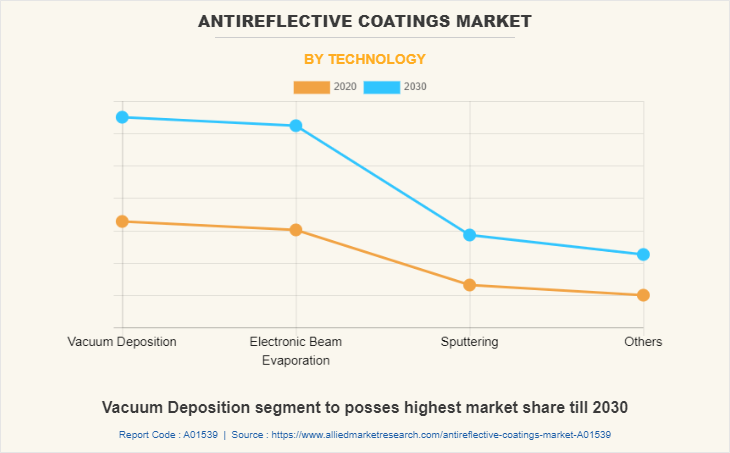
The vacuum deposition segment dominates the global antireflective coatings market. Vacuum deposition technology involves a variety of processes that deposit layers of the required material onto the optical surface. Vacuum deposition works at temperatures below atmospheric pressure. Vacuum deposition technology is primarily used for the application of anti-reflective coatings due to its extremely low environmental impact and maximum versatility. Vacuum deposition offers several advantages, such as creating an ecologically clean and reproducible environment for the process. Evacuation shows the greatest contribution to the overall share of the technology-segmented anti-reflective coating market. This is due to increased acceptance of this technology in anti-reflective coating applications. Factors such as more cost-effective coating technology and uniform application of anti-reflective coatings serve as a key growth drivers for expansion in demand. Vacuum deposition demonstrates the versatility of the coating process and requires minimal coating time. These factors offer a great opportunity to adopt this technology.
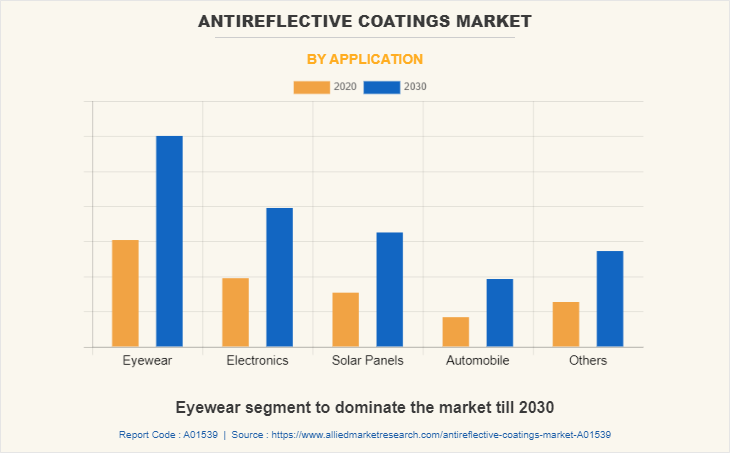
The eyewear segment dominates the global antireflective coatings market. According to the U.S. Department of Health and Human Services, myopia occurs in about 23.9% (about 34 million people) of the U.S. over the age of 40. According to World Health Organization (WHO), as of October 2021, approximately 2.2 billion people worldwide suffer from short-range or long-range visual impairment. The demand for progressive lenses has grown rapidly as more and more people suffer from presbyopia. Presbyopia is a condition in which the crystalline lens of the eye becomes harder with age, making it difficult to read at close range. Anti-reflection lenses are an affordable alternative to reducing glare reflected from computer screens, televisions, flat panel displays, and other electronic displays. Anti-reflective coatings are used to reduce glare and provide low reflectance. This makes the display easier to read, reduces eye strain, and improves visual insight. The presence of broad marketing conditions provides a favorable opportunity for market growth.
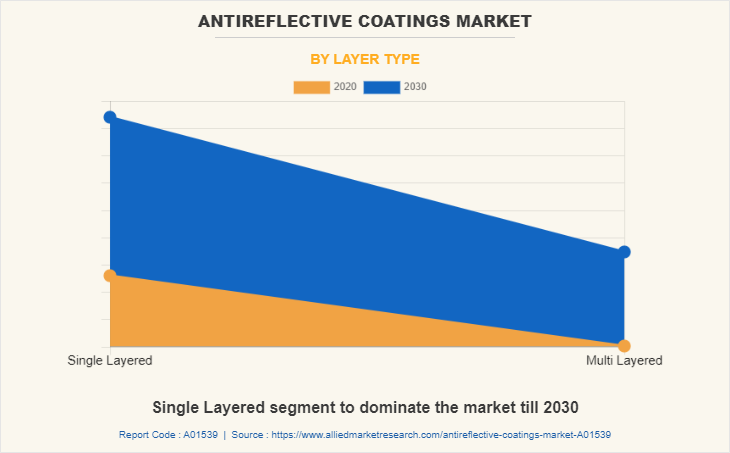
The single layer segment dominates the global antireflective coatings market. Single layer coating includes one layer of anti- reflective coating that covers a narrow range of wavelengths on the visible spectrum.The major factor of dominance is due to its low cost as compared to multi-layered coating coupled with comparative hardness and durability.
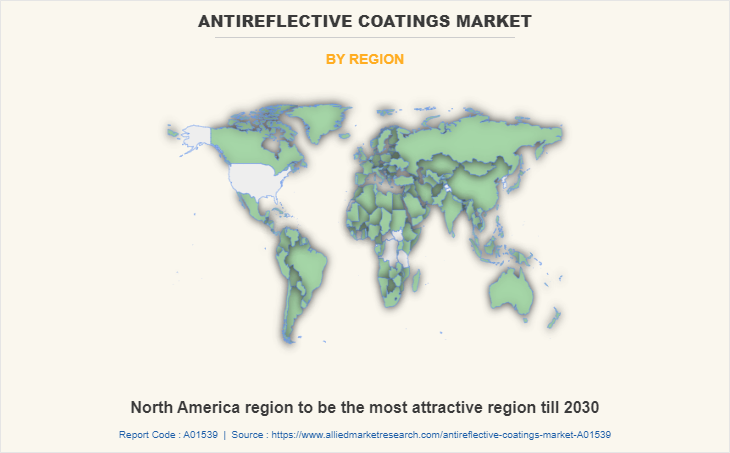
North America occupies the largest part of the antireflective coatings market and consists of countries such as U.S., Canada, and Mexico. Owing to increased demand for anti-reflective coatings in eyewear applications and growth in application in consumer goods such as smartphones, cameras, and flat panel displays in this region have created a lucrative opportunity for the market growth. Increase in the consumption of consumer goods is another major driving force for the development of the market in this region. The presence of major key players in this region, and the presence of demand for antireflective coatings in different manufacturing sectors augmented the market growth.
COVID-19 Impact Analysis
COVID-19 has severely impacted the global economy with devastating effects on global trade, which has simultaneously affected households, business, financial institution, industrial establishments, and infrastructure companies. The restrictions on international trade and lockdown regulations on the operations of the chemicals industry are projected to limit short term demand in the market.The market witnessed a slowdown since the pandemic knocked the doors of various international markets. The lockdown imposed by the government led to a major suspension of the market activities and the players had to bear the impact in the form of losses, reduced skilled labor, unavailability of raw materials for production, and much more. The market was functional during the permitted hours only, which hampered their ability to cater to the market demand and thus, disrupt the supply chain mechanism during the period.
Key Benefits For Stakeholders
- This report provides a quantitative analysis of the market segments, current trends, estimations, and dynamics of the antireflective coatings market analysis from 2020 to 2030 to identify the prevailing antireflective coatings market opportunities.
- The market research is offered along with information related to key drivers, restraints, and opportunities.
- Porter's five forces analysis highlights the potency of buyers and suppliers to enable stakeholders make profit-oriented business decisions and strengthen their supplier-buyer network.
- In-depth analysis of the antireflective coatings market segmentation assists to determine the prevailing market opportunities.
- Major countries in each region are mapped according to their revenue contribution to the global market.
- Market player positioning facilitates benchmarking and provides a clear understanding of the present position of the market players.
- The report includes the analysis of the regional as well as global antireflective coatings market trends, key players, market segments, application areas, and market growth strategies.
Antireflective Coatings Market Report Highlights
| Aspects | Details |
| Market Size By 2030 | USD 8.9 billion |
| Growth Rate | CAGR of 7.6% |
| Forecast period | 2020 - 2030 |
| Report Pages | 278 |
| By Application |
|
| By Technology |
|
| By Layer Type |
|
| By Region |
|
| Key Market Players | Rodenstock GmbH, ESSILOR INTERNATIONAL, E. I. du Pont de Nemours and Company, Hoya Corporation, PPG Industries, Koninklijke DSM N.V., Carl Zeiss AG, OPTICAL COATINGS JAPAN, HONEYWELL INTERNATIONAL, Viavi Solutions Inc. |
Analyst Review
As per CXO Perspective, antireflective coatings are optical coatings applied to the lenses, mirrors, or different optical surfaces to lessen reflection, growth transmission of light, and thereby allocating the throughput via way of means of controlling the reflexive index.
Anti-reflective coatings are extensively utilized in optics & eyewear, digital gadgets, sun panels, car industries, and different enterprise verticals. These coatings offer advantages together with advanced imaginative &prescient clarity, prolonged existence of the lenses, lessen blue mild exposure, and safety from UV rays. The boom of the worldwide anti-reflective coatings marketplace is attributed to the traits in eyewear, photovoltaic, and production industries. Increased installations of sun panels improve the call for anti-reflective coatings.
The Asia-Pacific anti-reflective coatings marketplace is predicted to develop on the quickest pace all through the forecast duration as a result of a growth with-inside the setup of sun panels in Japan and China. Almost 75% of the sun panels currently getting used are lined with anti-reflective coatings to save their degradation and to enhance their performance. The upward thrust with-inside the adoption of anti-reflective glasses for digital monitors and eyewear similarly fuels the marketplace boom. Approximately 90% of the eyewear utilized in Japan includes anti-reflective coatings.
The solar panel`s utility phase is projected to develop at the best CAGR for the duration of the forecast duration, as a result of a upward thrust in focus amongst governments closer to electricity conservation and solar power generation. The incorporation of anti-reflective coatings in solar panels complements the performance of light to electricity conversion via way of means by around 5%, in addition will also increase the general power output of solar cells. Multiple international locations together with China, Japan, and the U.S. actively encourage the use & improvement of inexperienced housing technologies.
Increase in demand for antireflective coatings from eyewear and photovoltaic industries are the key factors boosting the Antireflective Coating Market growth
The market value of Antireflective Coating in 2030 is expected to be US$ 8.9 Billion
Essilor International, Carl Zeiss AG, E. I. du Pont de Nemours and Company, Koninklijke DSM N.V., Honeywell International, PPG Industries, Hoya Corporation, Viavi Solutions, Inc., Optical Coatings Japan, and Rodenstock GmbH.
Consumer Goods and electronics industry is projected to increase the demand for Antireflective Coating Market
The antireflective coatings market is segmented on the basis of technology, application, layer type and region. On the basis of technology, the market is categorized into vacuum deposition, electronic beam evaporation, sputtering, and others. Antireflective coatings market application covered in the study include eyewear, electronics, solar panels, automobile, and others. On the basis of layer type, the market is categorized into single layered and multi layered. The global antireflective coatings market is analyzed on the basis of four regions, which include North America, Europe, Asia-Pacific, and LAMEA.
Growing adoption in the electronics industry is the Main Driver of Antireflective Coating Market
Eyewear end-use application is expected to drive the adoption of Antireflective Coating
The lockdown imposed by the government led to a major suspension of the market activities and the players had to bear the impact in the form of losses, reduced skilled labor, unavailability of raw materials for production, and much more. The market was functional during the permitted hours only, which hampered their ability to cater to the market demand and thus, disrupt the supply chain mechanism during the period.
Loading Table Of Content...
Loading Research Methodology...



